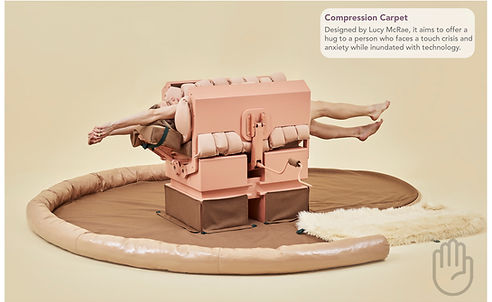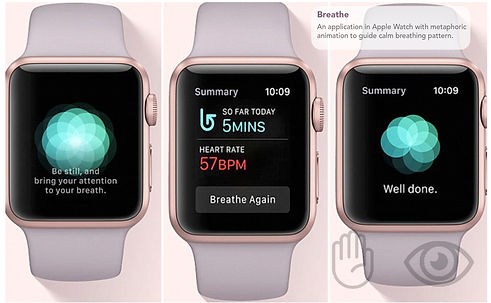

A companion pillow can guide your breathing pattern and to calm you down
Introduction
This project is my major project of master program, when millions of people worldwide are suffering from social isolation due to COVID-19 restriction. Precedents such as astronauts and researchers working in remote locations also reveal that isolation could cause negative impact of mental wellbeing. Learning from these examples, this project aims to engage sensory augmentation opportunities and mindfulness practice to ease negative effect of isolation, which can include anxiety, social disconnection and insomnia.
Problem Statement
Mental wellbeing in isolation
Concept
Soothe is a tactile companion pillow that helps achieve a calm breathing pattern and feeling of being hugged through providing appropriate patterns of light and warmth based on heart rate variability measurement. Personal and social possibilities are also considered in product-service, namely relaxation alone in comfortable lean-on posture, group meditation for various breathing techniques and social contact, as well as sleep guide in a lying posture. Finally it proposed a new possibility to use interactive technology as a satisfaction of our emotional needs while blending interface into people’s daily routine during periods of isolation.
Research

How can we engage SENSORY AUGMENTATION and MINDFULNESS EXERCISE
to ease negative effect of isolation?

Mindfulness & Meditation
Aiming to understand the effectiveness in different mindfulness skill in personal practice, I start to do some mindfulness exercises for deeper research according to suggested mindfulness exercises from Positive Psychology. Compared with short mindfulness exercises, I also did different meditation practice based on tutorials from Headspace application. All the effectiveness is assessed with my first view as a meditation beginner. Finally, this exploratory work reveals that breathing is the basis of all mindfulness exercises and meditation, as the most valuable direction of my project development. It is effortless and beginner-friendly for a broad user group.






Human-centric Research
For opportunity finding, I firstly made a quantitative survey of 83 participants, aiming to explore the impact of self-isolation upon stress and potential de-stress possibility. Then I conducted 5 con-call interviews, as a qualitative survey of opportunity finding, to understand interviewees’ feeling about stress in depth and details and reframed the empathy map based on these interviews.
The responses are also compared with literature review from desktop study and experts’ advices. Then 4 insights are concluded:
1. Too much focus on screen is the main reason of stress amplification
2. Sleep is disturbed with high stress, but it could be also cure.
3. Even though participants didn’t fill “mindfulness” in previous questionnaire, they still feel meditation and breathing adjustment are effective ways to ease stress in their previous experience.
4. Sight, sound, smell and touch could reduce stress level.
Technological Feasibility
The human-centric research reframed my research question: “How can we engage sensory augmentation and mindfulness exercise to ease negative effect of meditation?’ To seek the answer, this map was built based on analysis of experience patterns and technological feasibility on sensory augmentation projects. Most case studies focus on augmented reality and virtual reality combing audio-visual senses, which is still similar information outcome as screen based interaction. Therefore some problems in current interaction design are discovered:
1. Too many screens embedded in different appliances increases complexity in audio and visual information, requiring a large amount of attention.
2. Too many pop-up windows are overburdening users with overwhelmed information, and could cause anxiety and “phantom ringing syndrome”.
3. Current haptic feedback in human-computer interaction are mostly focus on vibration, but other haptic information is lost such as temperature, pressure and texture, which could mediate sensory intimacy through technology.
Finally, the criteria in this project could be:
1. Reduce unnecessary information complexity.
2. Engage touch, sound or smell to increase digital intimacy.
3. Blend interface into daily routine.
Precedents
3 insightful precedents inspired me intensively during case study and ideation: Compression Carpet is a critical design such like a hug machine focusing on similar context, when lack of physical contact impacts on mental wellbeing; Chromotherapy Sauna is a service implementing colours and light in interior design for stress reduction and relaxation; Breathe is an interface in apple watch with metaphoric animation and vibration to guide calm breathing pattern. My project developed based on a combination of advantages from these different precedents.
Ideation & Test

According to my research in mindfulness exercises, pillow and cushion are useful for beginners as comfort support. I was also inspired by sensory augmentation research and calm technology about blending interface and users’ daily routine to reduce task based user experience. Therefore the concept is a human-shaped pillow with embedded e-textile to simulating the feeling of being hugged to achieve digital intimacy while missing physical and social contact.
Then for more details, I used posture documentary and scale model for comfort development, and coded with sensors, e-textiles in sewable circuit to test the feasibility.
Final Product-service

Soothe is a haptic companion pillow to relieve anxiety, social disconnection and insomnia through a soft hug. The product-service also includes an app for mode selection and a wristband for heart rate variability detecting. The human-like shape and heater fabric from back can achieve a feeling of being hugged as a comfort support. Also, people can lie on it and hug it on a bed. To cope with anxiety and insomnia, it uses biometrics and appropriate lighting guidance to personalise slow-down breathing patterns based on meditative breathing techniques. To relief loneliness, people can join a group meditation with other people in remote location. They can practice various breathing techniques through audio broadcasting guidance when warmth makes them feel being hugged.


App
In this product-service, application is needed for product ordering, body data collection, device setting, and mode selection.
As per Castaldo et al. (2015), “high” and “low” heart rate variability is relative for each person because of different physical condition, so a basic body data collection is necessary for HRV and stress detection algorithm before use. For customisation possibility, Soothe also provide different fabric fill and colour for personal preference. A basic instruction about how to use the pillow in different modes is also necessary before people start their first session with Soothe.
In this stage I built interfaces in different steps to test whether users can understand how to use this product-service when they play with the app prototype. Volunteers found that when they only have the pillow, it is hard to imagine how it works. After they read the instruction in the app, it became easy to start the first session. During the session, they don’t need to watch screen, so it is not disturbing. In addition, they like customisation a lot because they have different body size.




Branding
Soothe aims to calm people down emotionally in daily life, so I choose a calming color palette with purple, blue and light grey to mediate its brand intention.
Through this product service, the goal is to promote people to notice how their heart reflects their feeling, and how a soft pillow can soothe them through hug and being hugged. So the main element of logo design is an illustrated hug and a soft shape of heart.
Digital Intimacy
Coping with the problems that lack of physical contact cause negative impact of mental wellbeing, there are already some precedents use warmth and pressure in a jacket or in a sandwiching machine to create a feeling of being hugged. Block and Kuchenbecker (2019) studied what patterns could increase feeling of intimacy using digital solution. Softness, warmth, and responsiveness are ingredients they found to improve intimacy in an artificial hug. Inspired by the study, I considered how Soothe could create its own digital intimacy by creating a soft interface.
Wristband
As per responsiveness in digital intimacy criteria of Soothe, wristband is the peripheral device connected with pillow automatically, to detect user stress level and provide appropriate light patterns. It keeps detecting user’s heartbeat, heart rate and heart rate variability when he is wearing it, so that the accuracy of stress detection could increase based on machine learning in long period and user’s basic body data.
Pillow
Pillow is the main component in this product-service during use. The side of the interface could be customised based on different handedness requirement. People can also choose their favourite fabric (velvet, lycra, felt, fleece and poly-cotton), fill (latex, feather, polyester and cotton), and colours.
Modes

Relaxation Alone
Relaxation alone mode aims to ease anxiety. In this mode, the wristband assesses user’s stress level with heart rate variability detection. And then the pillow can help user slow down their breathing pattern with personalised pace in breathing cyan light, which is a calming colour. When user achieves relaxation, he can practice mindful seeing in shifting rainbow light and feel warmth.
Group Meditation
Group meditation mode aims to ease social disconnection and provide various breathing techniques for users who want deeper meditative practices in pranayama. A group guider can guide group members by touching and releasing conductive fabric as well as voice broadcasting in different breathing rhythm, cycle, and round. Warm amber colour and warmth could provide them feeling of being connected.
Sleep Guide
Sleep guide mode aims to ease insomnia. The wristband detects HRV and help the pillow guide a slow-down breathing pattern. In this mode, the light is red for melatonin reproduction and avoids blue light disturbing sleep quality. Also, warmth is not allowed in this mode to avoid sleep- disturbing temperature.
